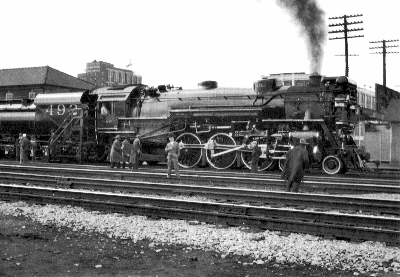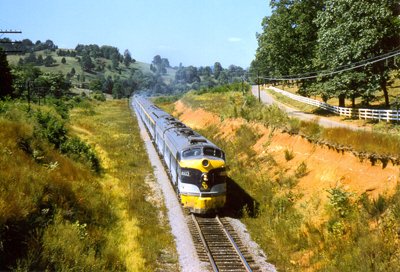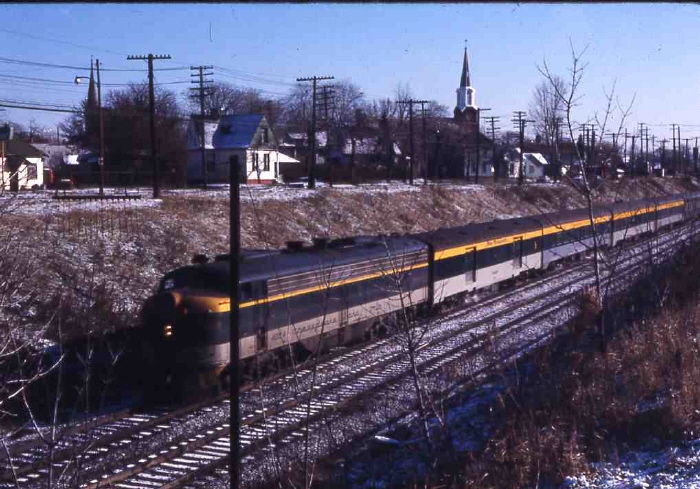C&O - The Sportsman
by Edward H. Miller
Train Nos. 4-46 and 5-47, The Sportsman, made its inaugural trip on March 30, 1930, on a somewhat different route for the Chesapeake and Ohio. It ran primarily between Newport News and Detroit, but with a good connection to Washington, D.C.
Click to enlarge
F-16 No. 464 leads The Sportsman at Columbus Union Station ca 1935. Photo courtesy of Chesapeake and Ohio Historical Society.The original locomotives for the train consisted of five heavy Pacifics, class F-19, and numbered 490-494. They had been built by Richmond in 1926. For inauguration of The Sportsman, the locomotives were shopped and given polished cylinder and valve head covers, polished air pump jackets and embossed eagles on the feedwater heaters.

Click to enlarge
F-19 492 at Huntington, WV March, 1930, during The Sportsman's pre-inaugural tour. Photo courtesy of Chesapeake and Ohio Historical Society.The Pullman-Standard order for lightweight passenger equipment that arrived in 1950 became the backbone of the C&O passenger fleet until the Amtrak takeover on May 1, 1971. While some cars were sold before delivery, the C&O kept 59 coaches, four buffet-lounge-observation cars (one was converted into office car 29), 43 10-6 sleepers and five double bedroom sleepers. The coaches seated 52 with a center divider. The buffet-lounge-observation cars became diner-dormitory cars. The 10-6 sleepers had the bedrooms in the middle and the roomettes at the ends. Since no diners were retained, many trains carried heavyweight diners.
Dieselization of the C&O's passenger service occurred as 27 EMD E-8's were delivered between August 1951, and January 1952. The use of steam locomotives in passenger service essentially ended during 1952. Four more E-8's arrived in May 1953.

Click to enlarge
Train 46, The Sportsman at Ivy, VA, September 1958, with E-8 4003. Photo by Gene Huddleston, courtesy of Chesapeake and Ohio Historical Society.
Click to enlarge
In the last months of The Sportsman, money was saved by laying off the switchtender on the west end ofColumbus Union Station. The Sportsman backed past CUS and entered the station from the east. Photo by Dave BungeApril 29, 1962 The Sportsman was discontinued east of Ashland and consolidated with The Fast Flying Virginian in that territory, but the schedule was better since No. 47 left Columbus around 7:30 a.m. After The F.F.V. made its last run on May 11, 1968, The Sportsman was consolidated with The George Washington. The Sportsman was cut back to just three days per week (Friday, Saturday and Sunday) effective August 2, 1970. By this time, it was running as an E-8, a food bar coach, and a P-S deluxe coach. It made its last run on April 30, 1971.

Click to enlarge
Train 47 just west of Toledo Central Union Station with E-8 4004, a baggage car, two coaches, a dorm/dinner,a B&O sleeper and a PRR sleeper (Jefferson County). Photo taken on November 15, 1967 by the author.Bibliography
Miller, Edward H., The Hocking Valley Railway, 2007, Published by Ohio University Press
Staufer, Alvin F., Shuster, Philip; Huddleston, C&O Power, 1965, Published by Alvin Staufer
Turner, Charles W; Dixon, Jr., Thomas W.; Huddleston, Eugene L., Chessie's Road, 1986,
Published by The Chesapeake & Ohio Historical Society, Inc.